やわらかい高分子における粘着・剥離の動力学解析
(Dynamical and multi-scale analyses on adhesion and debonding for soft polymeric materials)
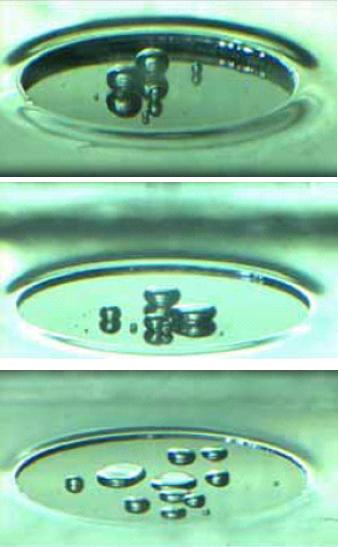
粘着剤と呼ばれるやわらかい高分子材料は,10kPa(ゴムの100分の1)程度の低い弾性率,
1000%を超える変形後も回復する巨大変形特性,tanδが1を有意に上回る粘弾性など,
ゴムなどの他の高分子物質と比較しても際立った力学特性を示す.また,粘着剤は,
硬化時間を経て強度を発現する接着剤とは異なり,被着体に接触させると瞬時に
接着力が得られるだけでなく,剥がしたり,再接着したりすることもできる.
そのため,粘着剤は,物体同士を短時間かつ容易に接合するための物質として,
粘着テープ,絆創膏,画面保護フィルムなどの製品に用いられているほか,
液晶パネルの貼り付け,半導体の加工,外科手術における固定,
ウェアラブルセンサーの装着など,最先端のエンジニアリングを
支える基盤物質となっている.
当研究室では,やわらかい高分子の粘着・剥離現象に関する多階層動力学を,
定量的かつ系統的に扱うための手法の開発を行っている.また,
研究成果をもとに,粘着・剥離の制御や多機能化に関する新たな手法の
提案を行っている.
Pressure-sensitive adhesives have several striking properties, such as
low elastic modulus (G〜10kPa), large deformability (ε〜1000%), and
large viscoelasticity (tanδ〜1). Furthermore, pressure-sensitive adhesives
exhibit unique adhesion performances. Owing to these advantages,
pressure-sensitive adhesives have been widely used in various situations,
like adhesive tapes, surface protecting films, and wearable sensors.
In this laboratory, we have been developing new methods to elucidate
the multi-scale dynamics in adhesion and debonding of pressure-sensitive adhesives.
We have also been proposing control and multi-functionality of adhesives.
[1] T. Yamaguchi, M. Morishita, T. G. Sano, M. Doi, Wetting dynamics of viscoelastic solid films, Soft Matter 18, pp.4905-4912 (2022).
[2] T. Yamaguchi, C. Creton, M. Doi, Soft matter 14, 6206 (2018).
[3] J. Nase, C. Creton, O. Ramos, L. Sonnenberg, T. Yamaguchi, and A. Lindner, Soft Matter 6, 2685 (2010).
[4] T. Yamaguchi, K. Koike, and M. Doi, Eur.Phys.Lett. 77, 64002 (2007).
[5] T. Yamaguchi, M. Doi, European Physical Journal E 21, 331 (2006).
[6] T. Yamaguchi, H. Morita, M. Doi, European Physical Journal E 20, 7 (2006).
疎な弾性ネットワーク材料の高靭化
(Toughening of sparse elastic networks)
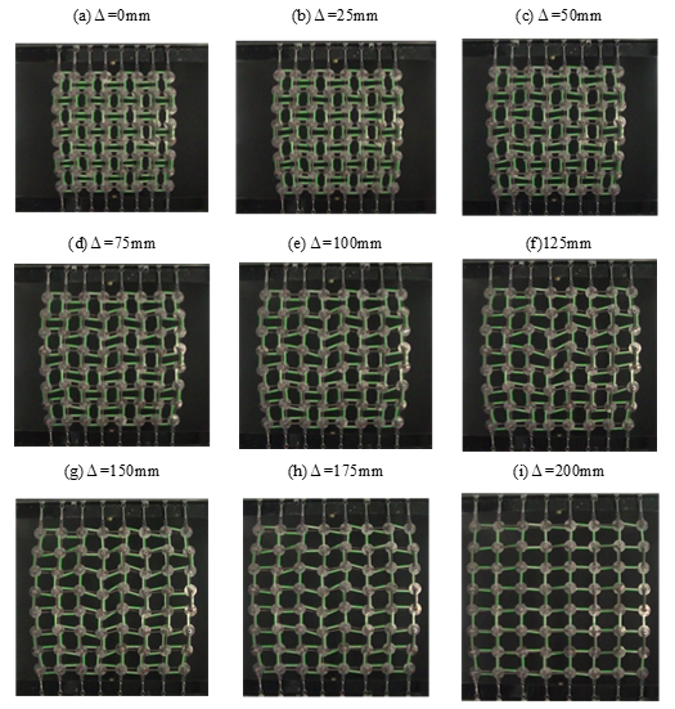
紐や梁が連結してできた疎な弾性ネットワーク構造は,高分子ゲルや網,発泡材など, 我々の身の周りに数多く存在する.このような疎な弾性ネットワーク構造の高靭化は極めて 重要な課題であるものの,研究例は非常に少ない.本研究では,とくにネットワークトポロジー とメタマテリアル構造に着目し,高靭性ネットワークの設計指針の確立を目指している.
The toughening of sparse elastic networks, such as hydrogels, foams, or meshes against
fracture is one of the most important problems in materials science. However,
the principles of toughening have not yet been established despite urgent
engineering requirements and several efforts made by materials scientists.
In our laboratory, we have been tackling with the toughening problem
by focusing on the topology and the metamaterial structure of a network.
[1] 山口哲生,メカニカルメタマテリアルの巨大変形挙動,メタマテリアルの設計、作製と新材料、デバイス開発への応用 .技術情報協会(2022).
[2] 山口哲生,トポロジー制御による網目構造の強靭化と高機能化,Cellulose Communications 29(1), pp.17-22 (2022).
[3] T. Yamaguchi, Y. Onoue, Y. Sawae, Topology and Toughening of Sparse Elastic Networks, Phys. Rev. Lett. 124 (6), 068002 (2020).
やわらかい弾性体のスティックスリップ摩擦と室内巨大地震実験
(Stick-slip friction of soft elastic bodies and laboratory earthquake experiments)
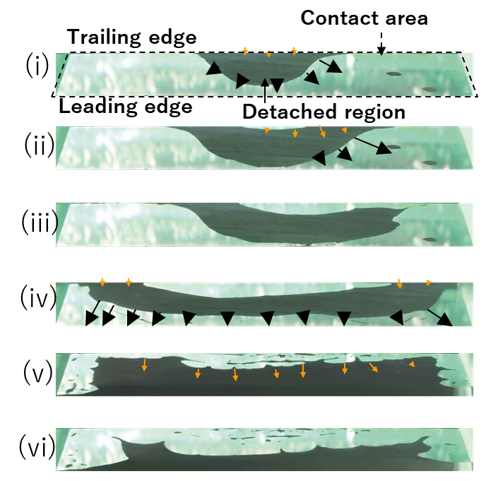
弾性体同士を摩擦させたとき,しばしば,固着とすべりを繰り返す,スティックスリップ運動を示す. スティックスリップ運動は,機械システムのみならず,プレート同士のすべりによって引き起こされる地震や, ワイパーのビビリなど,さまざまな状況で現れる日常的な現象である.当研究室では,スティックスリップ運動 を詳細に観察するため,高分子ゲルとよばれるやわらかくて透明な弾性体を用いて摩擦実験を行なっている. すべり素過程や応力・ひずみ場の可視化を通して,メカニズムの解明や挙動の制御を目指す.最近は, スロー地震と呼ばれる新しい地震現象のメカニズム解明を目指した研究も行っている.
When two elastic bodies are slid against each other, they often exhibit stick-slip motions with the repetition of lock and sliding. The stick-slip motions are observed in various systems, such as machinery, earthquakes, wiper chattering, etc. To observe the behavior in detail, we have been conducting stick-slip experiments using soft and transparent polymer gels. We are now aiming at understanding mechanisms and controlling the behavior through in-situ visualization of elementary slip processes, and stress/strain fields.
References[1] T. G. Sano, T. Yamaguchi, H. Wada, Phys. Rev. Lett. 118 (17), 178001 (2017).
[2] T. Yamaguchi, Y. Sawae, S. M. Rubinstein, Extreme Mech. Lett. 9, 331-335 (2016).
[3] T Yamaguchi, Y Himeno, Y Sawae, Proc. Malaysian Int. Tribol. Conf. 78-79 (2015).
[4] T. Yamaguchi, M. Morishita, M. Doi, T. Hori, H. Sakaguchi, J.- P. Ampuero, J. Geophys. Res. 116, B12306-1-8 (2011).
[5] M. Morishita, M. Kobayashi, T. Yamaguchi, M. Doi, J. Phys.: Cond. Matt. 22, 365104-1-6 (2010).
[6] T. Yamaguchi, S. Ohmata, M. Doi, J. Phys.: Condens. Matt. 21, 205105-1-7 (2009).
超音速すべり摩擦に関する研究
(Sliding friction at intersonic sliding velocities)
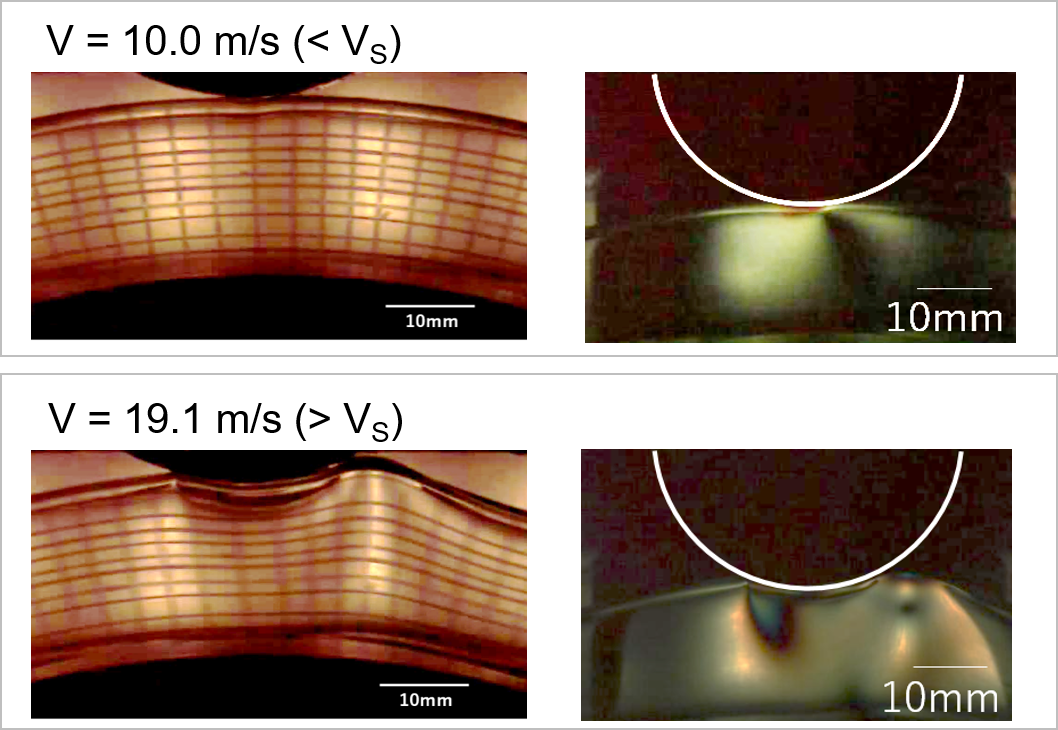
通常のすべり摩擦においては,すべり速度は物体中を伝ぱする弾性波速度に比べて極めて小さく, 動弾性の効果は無視できる.本研究では,高分子ゲルを用いることで,すべり速度が弾性波速度と 同等になる条件を実現し,そこで生じる摩擦挙動の観察を行った.その結果,世界ではじめて すべり摩擦の超音速遷移を見つけることに成功した.現在は,超高速での接触・摩擦機構の詳細を 明らかにするため,継続的な研究に取り組んでいる.
In normal situations in sliding friction, the sliding velocity is much smaller
than the elastic wave velocities of the solids. For this reason, effects of inertia
had not been considered in sliding friction.
In our laboratory, by utilizing soft polymer gels as frictional materials,
we succeeded in realizing the sliding condition where the sliding
velocity is comparable to the wave velocities, and also succeeded in
observing the intersonic transition for the sliding behavior.
We are currently studying the detailed mechanisms in such an abnormal situation.
[1] 山口哲生,家敷拓弥,森田健敬,澤江義則,超音速すべり摩擦,日本物理学会誌 77(7), 464 (2022).
[2] T. Yashiki, T. Morita, Y. Sawae, T. Yamaguchi, Subsonic to Intersonic Transition in Sliding Friction for Soft Solids, Phys. Rev. Lett. 124(23), 238001 (2020).
木材に浸透した接着剤の共焦点レーザー顕微鏡観察
(Laser confocal microscope observation of adhesives penetrating into wood)
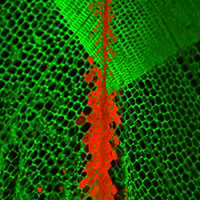
木材への接着剤の浸透は,接着強度を支配する極めて重要な因子である. 当研究室では,蛍光剤を混入した接着剤を用いて木材を接合して試験片とし, この断面を走査形レーザー顕微鏡で観察することで,接着剤の浸透の可視化を行った. また,観察像へ画像処理を施すことにより,木材内部方向への接着剤の存在確率と分布を求めた. この手法により,木部と接着剤の分離が高精度に実施でき,定量的分析が可能になった. 現在は,木材接着について高い信頼性を持たせるためのさらなる検討を行っている.
The penetration of adhesives into wood is one of the most important factors determining adhesion strength.
In our laboratory, we developed the visualization technique for the penetration of
adhesives using a laser confocal microscope. By applying image processing, we succeeded
in separating wood part from adhesive, and also in evaluating the penetration behavior
in a quantitative manner.
We are currently extending the method to offer high reliability on wood adhesion.
[1] 藤井祐樹, 堀成人, 竹村彰夫, 加茂誠貫, 深沢文雅,走査型レーザー顕微鏡観察と統計解析を組み合わせた方法による接着剤浸透の評価: スギ-フェノール樹脂接着体での冷圧時間または接着剤塗布量の影響-,木材工業 66, 54-57 (2011).
[2] 堀成人,木材接着体に分布した接着剤の走査形共焦点レーザー顕微鏡を用いた観察,日本接着学会誌 47, 283-289 (2011).
[3] 堀成人, 竹村彰夫,接着剤の木材への浸透性の評価 :木材工業 65, 100-105 (2010).
[4] 日本テレビ系番組「所さんの目がテン」で紹介されました(2020年09月20日).
樹皮由来のタンニンを化学的に組み込んだフェノール樹脂接着剤の開発
(Development of phenol resin adhesives including bark-derived tannin)
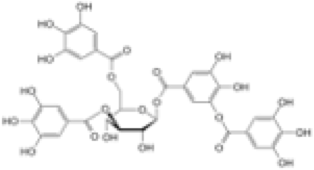
木材樹皮は,木材工業において大量に発生し,副産物としての量的割合は最も多いものの, 現場ではボイラーの助燃剤といった用途に限られている.木材樹皮由来のタンニンを利用する研究は 古くから存在するが,特に有用と認められた利用法は少ない.タンニンは多数のフェノール性ヒドロキシ基 を持つ芳香族化合物である.本研究は,微粉末にした樹皮をそのまま接着剤の増量剤としつつ, そこに含まれるタンニンをフェノール骨格を供給する多価化合物として組み入れた タンニン-フェノール-ホルムアルデヒド樹脂接着剤の開発を目指す.
References[1] 中田健人,フェノール水溶液可溶な樹皮抽出物を組み込んだ新規フェノール樹脂接着剤の開発,東京大学農学部生物素材化学専修・卒業論文(2021).
機械・接着ハイブリッド接合を用いた木質構造接合部の力学特性
(Mechanical properties of mechanical/adhesive hybrid joints in timber structures)
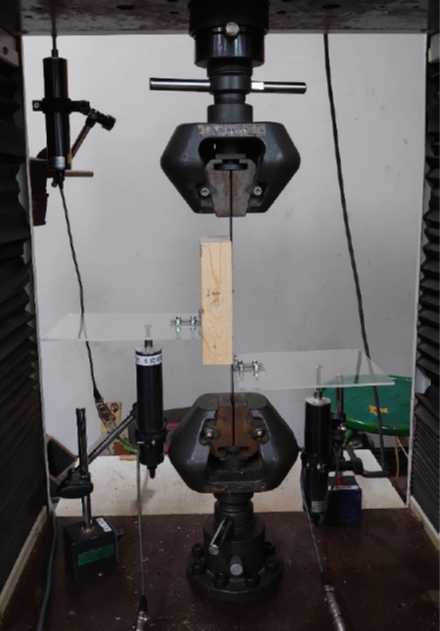
木質構造の接合部においては,小さな外力に対しては剛直に振る舞い,強震動などの大きな 外力に対しては粘り強く振る舞うことが求められる.このような要求を満たすためには, 高い靭性を持つビスやボルトなどによる機械接合だけでなく,高い剛性を持つ接着接合を 併用したハイブリッド接合が効果的であると考えられる. 当研究室では,木質構造接合部でのハイブリッド接合の破壊挙動に焦点を当て,接着接合と 機械接合の効果的な併用方法を明らかにするための基礎研究を行っている.
The joints of timber structures are required to be tough against strong forces, and to be stiff for weak forces. To satisfy these requirements, hybrid joints, which are a combination of a mechanical joint with high toughness and an adhesive joint exhibiting high stiffness, are considered to be effective. In our laboratory, we have been focusing on the fracture behavior of the hybrid joints in timber structures, to elucidate the optimum combination between mechanical and adhesive joints.
References[1] K. Imakawa et al., Mechanical Properties of Hybrid Joints in Timber Structures, Journal of Wood Science 68(1), pp.1-8 (2022).
[2] 今川皓介,機械接合と接着接合を併用した木質構造接合部の力学的性質,東京大学農学部生物素材化学専修・卒業論文(2021).